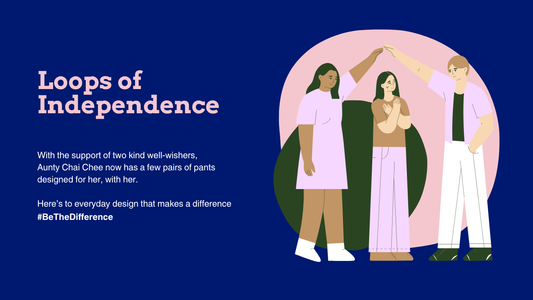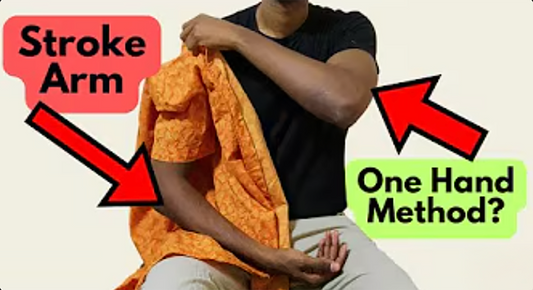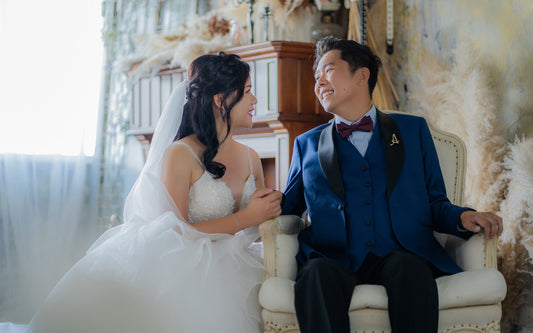
Clothes For The Disabled Should Matter | ELLE Singapore
One small step for Singapore, one giant leap towards more inclusive fashion
Fashion should be for everyone, no matter your age, size, ethnicity or gender. Unfortunately, the reality is that it’s not always made that equal.
But a pair of Fashion Design and Textiles graduates from LASALLE College of the Arts is taking a step towards greater inclusivity in fashion. They’re designing for one oft-neglected group — those with special needs.
For their graduation showcase, an event done in collaboration with Swarovski, Elisa Lim and Ethrisha Liaw created an extra-special collection titled 1000 MPH for wheelchair users.

Besides featuring a sporty, athleisure aesthetic, each piece in the collection boasts practical details that provide relief to wheelchair users. We spoke to Lim and Liaw for a closer look at their designs, why wheelchair users need special clothing, and what this forward-thinking line means for the fashion industry in Singapore.
What motivated you to design a wearable therapy collection for wheelchair users?
ELISA LIM: I started working on adaptive clothing two years ago when I was approached by a doctor to design clothing for his bed-bound patients. While doing research and speaking to people with different disabilities, it occurred to me that clothing functions could enable them and improve their daily lives.
Whether is it to help caregivers dress the wheelchair users quicker, or to provide users some form of independence and dignity while dressing, there is a need to make clothing comfortable and fitting for the seated posture. Besides, the functions that we have come up with through this collection have been innovated as a universal design that is better for everybody, seated or standing, to provide comfort and good fit.

ETHRISHA LIAW: My initial research for studio work was actually focused on therapy, specifically for people suffering from anxiety, so it was really looking at how materiality in touch and fidgeting could possibly provide relief. I believe beyond being a source of nostalgia — in the form of personal ‘chou chou’ [literal translation: smelly smelly] pillows we had as babies — “contact comfort” is essential to our psychological development and emotional health. I wondered if we could build on this biological affinity we have with materiality to be translated into “textile therapy”.
When Elisa asked me onboard the project, I realised that wheelchair users’ proximity with surfaces — being unable to move around freely, causing them to spend most, if not all of their time either sitting, or lying in bed — cultivated a very specific taste in textiles. Seeing as how tactile and thermal comfort is a priority and challenge for wheelchair users in Singapore, I then decided to investigate and build on this intuitive affinity they share with surfaces, in the hope of possibly furthering aesthetic wearables as avenues of haptic healing.
We realised that we could possibly have the best of both worlds, feeding our findings into a more conclusive collection on adaptive wearable therapy, that could ply the chasm in the adaptive market, providing the bridge between function and fun through rethinking construction with a propensity for feel-good textiles.
"We hope to use fashion to empower lives, to provide practical solutions for persons with different needs in our present culture and climate. It’s about forging an inclusive community, whereby everyone is respected, treated equally and has equal opportunities. It’s about eliminating discrimination and valuing diversity."
What was the inspiration behind this collection?
ELISA & ETHRISHA: Inspired by the abstract geometric forms of the ’80s complete with ’90s colour blocking and graphic drop shadows, we looked to the keyword PLAY offered by modern digital standards.
Italian photographer Fabrizio Raschetti’s study of bold angles and compositions in sports photography, applied within the principles of American artist James Turrell’s spatial constellations, sparked the idea of providing dimensional play and structural relief through the use of accent lines and fresh gradients. So, proportion is redefined visually, as colour is used to suggest space. Shape takes on mass, and balance is redistributed.

Sports elements such as ping pong tables, soccer pitches, basketball courts and swimming pools serve as inspiration for print. We seek to create a sense of dynamic movement with our carefully curated aesthetics through creating spatial experiences, and comfort in its make.
What was your design process for this collection?
ELISA: We spent a lot of time understanding users’ needs and desires by running many different tests, focus groups and interviews. Followed with rounds of prototyping and getting feedback from our participants to learning application of Swarovski crystals. Even after the final pieces were completed, we were still asking for feedback, and thankfully it has been very positive.
ETHRISHA: The design process marked many firsts for us. The first challenge for me was being objective — being able to discern between our assumptions as to what they want, and what they truly want and need. I believe this boils down to the mentality with which we approached the subject of disability.
"Society has given them many false labels, of being people who need help, and initially, we failed to realise they are just as diverse as we are."
We took to loaning wheelchairs from Gardens by the Bay to try understanding what it was like emotionally and physically negotiating public spheres in a chair. The first thing I noticed, was that it was intimidating travelling through the crowds at waist-level.
Also, people smiled more than they should have. I felt compelled to return the smile, even though there was no clear reason why the exchange was necessary. We realised managing emotions in public in a chair was vastly different from that being in public as an able-bodied person. Through this field research, we also unanimously decided that our top priority was breathability.

It was also difficult cutting the balance between striking and subtlety. As fashion designers, we could not approach this topic from the angle of product design, which would build on the concept of form follows function. My plans were initially to have the garment be somewhat of a stress ball, with parts that were detachable, a chameleon of a suit. I thought about the idea of inculcating textures similar to our chou chou pillows from yore, or transitional objects if you would have them, within the garments on the elbows or places that were easily reachable.
Elisa and I even visited a sex store to check out the safe silicon objects on sale for inspiration. This was because sex toys came to mind when we were brainstorming on materials that were most intimate to us.
However, our lecturers required the clothing to be visually eye-catching and pleasing on the runway, whilst results from our tactility and colour tests proved that our wheelchair users preferred practical, simple get-ups that were not loud.
Through the process of going back and forth between our lecturers and the wheelchair users, it became clear at a point that it was not about what they wanted to look like, or embody. This is because they are just as diverse as we are, and there was no end in sight, or conclusive data that pointed to a single direction.
"We realised that our role was solely to gain insight into the more functional areas of clothing they need, silhouettes they were comfortable with, and then gave these shells our own spin on the art direction."
We churned out 70 colour palettes, 30 different textile swatches and over six different styles, from athleisure lux to delicate prettiness, and the choice of Swarovski crystal and application techniques. We then had our wheelchair users pick their preferences. It took us a lot of time to reach that understanding, so production was pushed back, and had to be processed in less than a month. That was another challenge we had to face.

On a personal level, this project was really challenging because it was a collaboration. It was two creative minds negotiating preferences and styles, and we had to sit through each sketch and reach a mutual agreement on what we thought was the best. Of course, this also meant that we had two very creative heads to think of ideas and ways of fastenings, colours and concerns. Eventually, I found joy in each compromise. I found joy in our diversity, as we applied our strengths where the other was weak. This journey taught me that limitations are good, because then you would know what is truly important, and what you can, alas, forgo.
What design elements are unique to fashion for wheelchair users? How is it different?
ELISA & ETHRISHA: Specific cutting techniques have been developed to provide the right fit, used on quality textiles in the form of silk crepe to provide the right stretch. Box pleats are explored in this collection to adapt the clothing to both the standing and seated postures, to encourage inclusivity in fashion. Easy ways of fastenings are applied with the use of magnets and open-ended zips that are sewn upside down, to relieve the difficulty of changing.

How will the different design elements provide relief to wheelchair users?
ELISA & ETHRISHA: The construction of the clothing provides premium fit and comfort that allows wheelchair users to feel great throughout the day. Besides, it drastically shortens the time to dress and undress, which makes dressing daily less of a chore.
How have you incorporated Swarovski crystals into your designs?
ELISA & ETHRISHA: Textile therapy is applied within the collection in the form of mobile wearables — beads that are fun to fiddle with placed strategically at places of reach, coming into play as a direct and physical way to ground emotions, relieving and displacing anxiety.
This concept works somewhat like that of the fidget spinner and fidget cube, that are gaining ground in being recognised in helping people to focus and learn better, except applied on clothing. Swarovski crystals are also used as an extension to the gradient play in prints.
How have principles from Traditional Chinese Medicine been injected into this collection?
ELISA & ETHRISHA: The beads are also applied on meridian lines according to the principles of Traditional Chinese Medicine to provide wellness through the tactility of dress, to stimulate blood circulation. Stimulating these points with heat, needles or pressure (in this case, Swarovski pearls), triggers the release of endorphins — the neurochemical that relieves pain. As a result, pain is blocked and the flow of blood and oxygen to the affected area is increased. This causes the muscles to relax and promotes healing. Beaded knitted gloves and leg warmers are used as mobile massagers.

Why do you think fashion for those with special needs is important?
ELISA & ETHRISHA: Fashion has the potential to shape perspectives; it reflects who we are and how we express ourselves.
"Fashion as a whole needs to better reflect the people it serves, to represent the world as it actually is, because it is for everyone and we should celebrate as many women as we can. We need more education and more conversation, especially right now, when the industry is begging to be disrupted, and here we have a community that is demanding to be understood."
The fashion industry needs to recognise that the representation of disability is a chance to explore new textures, silhouettes and a completely different audience to what they were previously accustomed to.
How do you hope your collection will bring attention to the need for social design in Singapore?
Hopefully this project will inspire designers to innovate and design for a cause, something that benefits a wider crowd. An innovation that is bigger than oneself.
As Brit graphic designer Michael Wolff puts it: “When you include the extremes of everybody — that is to say, differently abled people of all sorts — then you produce things that are better for all of us.”
–



